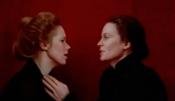The Feeling of Spectators and Poetics of Affect
How do audiovisual media (especially film) affect us? What makes us cry, laugh, or shiver? Through the composition of expressive patterns of movement (expressive movements), audiovisual media can evoke moods, atmospheres, and emotions as an affective as well as a physical reaction in viewers. From within this assumption, a specific perspective upon audiovisual media opens itself up which forms the basis for various research foci: Meaning Making and Embodiment, the Aesthetics and Politics of Audiovisual Images, Sense of Community, Genre, and History, as well as the Poetics of the Weimar Cinema.
Cinema, Melodrama, and Sentimental Drama
The monograph Matrix der Gefühle, which was written as a habilitation thesis, follows the question as to why we cry in the cinema. In order to answer this question, the study seeks to describe the melodramatic as a specific mode of cinematographic expressivity. The book is subdivided into three sections which explore the phenomenon of a sentimental enjoyment closely associated with the melodrama from different perspectives: from a genealogical one, a phenomenological one, and in relation to psychoanalytical film theory. This investigation connects the sentimental drama of the eighteenth century with contemporary Hollywood film.
An overarching principle that comes into view is the modulation of the spectators’ feelings through the temporal structure of their concrete experience. The cinematic image – just like the theatre stage in the period of sentimentalism (‘Empfindsamkeit’) – becomes a face itself: a whole which goes through a transformation and thereby constitutes a duration. The term ‘expressive movement’ describes just that process, one side of which presents the visible movement of the image (the characters, the camera, etc.), while the other is carried out internally by spectators: The dark auditorium as a matrix of emotions.
Further information about the book > Publications > Monographs > Matrix der Gefühle. Das Kino, das Melodrama und das Theater der Empfindsamkeit.
An exemplary analysis of Magnificent Obsession (Douglas Sirk, USA 1954) from Matrix der Gefühle was audiovisually prepared in the context of the eLearning-project Bildräume, and illustrates how the synaesthetic tissue of gestural acting, décor, color, music, montage, and camera movements can be understood and analyzed as cinematographic expressive movements.
The fourth dimension of the moving image
In Ausdrucksbewegung und Zuschauerempfinden, as well as Die vierte Dimension des Bewegungsbildes, the various layers of cinematographic movement are investigated and differentiated in regards to the theory of montage by Sergej Eisenstein.
Beyond representation and spatial figuration, the investigation is mainly concerned with the movement which threads through the film as a whole: The unraveling, unfolding, unveiling of a specific world of perception of each film in the presence of a spectator’s physical perception. As a perceptive, thinking, and sensitive subject, the spectator thus realizes film as a chaining of intensity.
The film, understood as a dispositif of perception, becomes an embodied reality, a physical-psychological whole – which is not that of the spectator. The titular fourth dimension denotes the time in which the film unveils the spectator’s perception as a world that follows its own laws and rules. The sensitivity and sensibility of such a world fundamentally differ from our everyday perception of the world.
Further reading:
Ausdrucksbewegung und Zuschauerempfinden: Eisensteins Konzept des Bewegungsbildes.
In: Synchronisierung der Künste/Robin Curtis, Gertrud Koch, Marc Siegel (eds.). 1. edition. München, 2013. p. 73-84
Die vierte Dimension des Bewegungsbildes. Das filmische Bild im Übergang zwischen individueller Leiblichkeit und kultureller Fantasie. In: Audiovisuelle Emotionen. Emotionsdarstellung und Emotionsvermittlung durch audiovisuelle Medienangebote / Anne Bartsch, Jens Eder, Kathrin Fahlenbrach (eds.). First edition. Köln: Halem, 2007. p. 297-311
When looking at JEZEBEL, a world emerges for the spectator during the duration of the film, which through its sensorial nature establishes an opposition in the terms of master/servant, man/woman, slave/citizen. In the spectator’s perception, the protagonist is the link between these poles, for „[i]n ihr verlangt die Beweglichkeit der Sklaven und die Kraft der Pferde ihren Platz in der ‚guten Gesellschaft‘“ (“in her, the agility of the slaves and the power of the horses demand their place in ‘good society’”).
“In her riding costume, her feathered hat, her gait forced by twists and turns, Julie's first appearance introduces her as the dynamic center of power associated with the wildness of the horse. In stark contrast to Julie's appearance is the arrival of the party guests, seen immediately before: the movement radius of this party seems as restricted as Julie's one is expansive.”
(„In ihrem Reitkostüm, ihrem federgeschmückten Hut, dem durch die Wendungen und Drehungen forcierten Gang ist Julie mit ihrem ersten Erscheinen als das dynamische Kraftzentrum eingeführt, das mit der Wildheit des Pferdes assoziiert wird. Im strengen Gegensatz zum Auftritt Julies steht die Ankunft der Gäste, die unmittelbar zuvor zu sehen ist: Der Bewegungsradius dieser Festgesellschaft wirkt so eingeschränkt wie der von Julie expansiv.“)
Motion and Emotion
The in-depth-reading of Eisenstein in Die Anschaulichkeit des Sozialen und die Utopie Film makes clear that for him, the transition from the projected image to the audience’s perception is only another step in the unfolding of a singular movement which within the cinematographic image is carried out through dialectic jumps – thus directly leading from motion to the e-motion. The audience’s own emotional response thus remains a part of the film’s montage of movements; therefore the montage can be understood as a link between opposite expressive movements, which include the spectators’ specific affective responses.
Further reading:
Die Anschaulichkeit des Sozialen und die Utopie Film. Eisensteins Theorie des Bewegungsbildes. In: Movens Bild. Zwischen Evidenz und Affekt / G. Boehm (ed.). First edition. München: Wilhelm Fink, 2008. p. 301-321
A five-part video lesson regarding Eisenstein’s Theory of Montage was created in the eLearning-project Bildräume.
Film and Face – Film as Face
The special relationship between the face and the cinematic image in terms of their potential to move the spectator emotionally is the focus of the essay Bühne der Empfindungen, Leinwand der Emotionen - das bürgerliche Gesicht from the anthology Blick, Macht, Gesicht, which was co-published by Helga Gläser and Bernhard Groß. From the Ancient Egyptian death masks through the Dutch portraiture of the 15th century, and Diderot’s Theory of Acting of the 18th century, all the way to the face on the cinema screen, an idea unfolds of the specific role the face plays as a medium of sensitivity and sensation. For within it, the expressive movement (facial expressions) and the sensation movement of the spectator collide: reading a face is only possible in relation to one’s own physicality. With Belà Balázs and Gilles Deleuze, the face becomes the paradigm of the cinematographic image: the movements on screen are similar to the mimic movements of the face, and the cinema becomes a space of artificially created affects, of the technically animated soul.
Further information about the book: Blick Macht Gesicht
“The Thin Red Line is this face-to-face, continuous, stunned amazement that continues in the wind-driven cloud shadows and the flashing light that breaks through the jungle vegetation. It manifests itself as a movement in which the waving of the grass, the gliding of the shadows and the light splintering in the foliage combine with the widening and narrowing, sometimes striding, then flowing soundscape of the film music: a spaceless movement [of affect] that is structured by the anonymized faces like a Homeric epic in verse. [...] It is the space of the viewer's sensations, his sensual, affective and libidinal interweaving with the world. For us in Western culture, the aggregate of this affective relationship to the world is the face.”
("The Thin Red Line ist dieses von Gesicht zu Gesicht überspringende, sich fortsetzende, fassungslose Staunen, das sich fortsetzt in den vom Wind getriebenen Wolkenschatten und dem blitzenden Licht, das durch die Urwaldgewächse bricht. Es bekundet sich als Bewegung, in der sich das Wogen des Grases, das Gleiten der Schatten und das im Blattwerk zersplitternde Licht mit dem sich weitenden und verengenden, mal schreitenden, dann fließenden Klangteppich der Filmmusik verbindet: eine raumlose Bewegung [des Affekts], die von den anonymisierten Gesichtern gegliedert wird wie ein homerischer Epos vom Versmaß. [...] Es ist der Raum der Empfindungen des Zuschauers, seines sinnlichen, affektiven und libidinösen Verwobenseins mit der Welt. Das Aggregat dieses affektiven Weltbezugs ist für uns in der westlichen Kultur das Gesicht.")
The Overwhelmingly Large Face of the Screen
From a psychoanalytical perspective unfolded in Der Film: Ein Text, ein Bild, ein Objekt, the connection of film and face plays just as central a role in affecting film spectators.
Especially when perceiving the affective sensations of a close-up, the spectators view themselves as powerless individuals opposite an overwhelmingly large face on a screen, displaced through the proportions into a relationship of proximity which seems to directly imitate the mise en abîme of sensations between infant and mother.
At the same time the face is not a text, yet still a ’message’ which produces itself within the physical effect, within the face’s mimetic formation of symptoms in the other. The face constitutes the subject’s inner world as a physical symptom, which has always been there, an early age of the self that is followed by self-consciousness as a later ‘translation’.
The recipient’s feeling behaves like the dreamer: in each detail of perception, in each element of presentation it finds a temporary habitation. The symbiotic melting of the viewer with the cinematic images and their movement is based on a mimetic and affective reading of the film which can be described as a continuous transition between the inner and outer reality, between the material and the mental things.
Further reading:
Der Film: Ein Text, ein Bild, ein Objekt. Zur psychoanalytischen Theorie des Zuschauers. In: Texte zur Kunst, Heft 68, Dezember 2007. Berlin 2007.






